|
observer |
|
|
|
|
|
OTHER LINKS |

|

|

|
ArtsMonarawila: Patriots and traitors of our time
The story begins with Assistant Government Agent of Matale (AGA) discovering a letter by Ven. Paravagama Sumangala Thera. The letter reveals details about the persons who betrayed the nation and worked along with the British against the "Uva Wellassa" rebellion of 1818. The "Uva Wellassa" rebellion of 1818 was masterminded by national heroes such as Kiulegedara Mohottala, Kohobure Rate Rala and Ehalagama Unnanse. The rebellion spreads to Matale, Satara Korale and Nuwara Kalaviya as Kappitipola joins the rebels. Kappitipola's wife and Tikirikumara go underground and hide in Matale in fear of being captured by the British. Kiulegedara, a leader in the rebellion meets Swarnamali and marries her. The rebellion under the able leadership of Kappitipola poses a serious threat to British rule in Sri Lanka. However, leaders like Thaldena Mohottala allies with the British in betraying the nation.
Though Swarna was widowed by the death of Kiulegedara, she was able to kill Thaldena. On reading the Sumangala Thera's letter, Allepola and former MP who is a descendent of the Wasala Bandara clan (vernacular physician's dynasty similar to Monarawila), found out a conspiratory plan to sell 30,000 acres of land within biodiversity to foreigners. Wasala Bandara is a vernacular physician and his daughter Anuthara is a lawyer. Wasala Bandara and Allepola discover that there is a racket to export priceless genes from Sri Lanka and that those who purchase the land are involved in that racket. The proprietor of the company who aided the British in the rebellion, is Deepal Eknaligala and his friends. Oushadi, a girl Deepal tried to abuse, tries to trap Deepal and she resembles Swarna in the 1818 rebellion. Meanwhile, Deepal and Eknaligala, sensing Wasala and Allepola are trying to expose them and attempt to kill them. Allepola starts an affair with Anuthara. Sumangala Thera who joins Wasala and Allepola in exposing the racket was killed by Deepal. Oushadi and Ayasha who were abused by Deepal discover more about the racket. Allepola loses an eye in the attack by Deepal and he abandons the idea of marrying Anuthara. Allepola losses his employment due to political interference. However, Wasala's exposure turns the table on Deepal and Allepola gets his job back and they find out how in collaboration with a foreigner, ancient formula, herbs and genes were exported from Sri Lanka. The racket was nabbed by the police with help from Wasala and Deepal who were injured in the incident and fled and receives treatment from a vernacular physician. Police arrest Deepal on a tip- off by Oushadi and Ayasha. Monarawila is scripwritten by K. B. Herath and playback music is by Rohana Weerasinghe. Fierce love at Punchi Theatre
Namel Weeramuni has the answer. Through the revival of the adaptation of Henrik Ibsen's play, Gahaniyak, in 1965 as Gindarai Adarayai he brings to life once more, Ibsen's most compelling and conflicting character, Hedda Gabler, at the Punchi Theatre on June 23, 24, and 25, 2006. According to Namel Weeramuni, the new script is a changed version of the one written by Prof. Sunanda Mahendra in 1965. "The script I am using in Gindarai Adarayai is a combination of the original play by Ibsen, and the script of Gahaniyak. In the original play, two scholars are doing research on civilization, but I changed this to have one scholar studying the history of cancer and AIDS, while the other scholar tries to find a cure for these two diseases". Talking about Heddar, who was brilliantly portrayed by Malini Weeramuni, back in 1965, he says even though Hedda is a woman who is in her early thirties the role has always been played by mature actresses, who are capable of capturing the volatile and vulnerable nature of the protagonist. Here's how the frustration of Hedda is revealed through the conversation between an aunt and Hedda's husband. "I was in the library during the six months we were in Paris. There were so many books to read" He tells her, to which she says "You seem to have spent your honeymoon in the library." With the exception of Malini Weeramuni who plays the role of the aunt the rest of the cast comprise newcomers - "all lawyers who are quite professional as actors" says Namel Weeramuni. Eshanthi Mendis, an actress blessed with innate grace portrays the character of Hedda, struggling to come to terms with her husband (Senaviratne Bandara), whom she finds numbingly dull, while Asela Serasinghe takes on the role of the brilliant professor. Arundathi Fernando is the friend, Manesh Wavita, the lawyer and Dilhara Subasinghe, the servant. Called the "Female Hamlet", making one wonder if she is an idealistic heroine, a victim of circumstances or a villain, the story of Hedda who manipulates the fates of all who enter her orbit till she eventually goes too far in Adarayai Gindarai is bound to give a high to every drama addict yearning for intelligent entertainment. Film review:Ran Kevita to mark Children's Year
Shooting of Ran Kevita, a children's film by Udayakantha Warnasuriya was concluded recently. The film shot in different locations like Ambilipitiya, Suriyawewa, Tissamaharama and Situl Pahuwa, was produced on behalf of Millennium Entertainment by Ranjith Jayasuriya, Ivan Jayaratne, Janitha Marasinghe and Udayakantha Warnasuriya. Udayakantha who earned laurels for films such as Gini Avi Saha Ginikeli, Mahamera Usata, Rajya Sevaya Pinisai and Yakada Pihatu, has ventured to produce Ran Kevita to mark the International Children's Year 2006. The story is woven around a group of children, Suran, a 12-year-old boy and his friend, Janith. On a school vacation, the two friends go on an adventure to explore the panoramic beauty of a village. They visit another friend and find an Unahapuluwa. They get an idea and visit the village temple. The friends meet the Podi Hamuduruwo and find an ola leaf containing a legend on the Unahapuluwa. According to the legend, if one gets a tear from Unahapuluwa and mix it with a secret formula and apply it on one's eyes, one can see the Gopalu Yaka, the devil possessed cattle. The Gopalu Yaka has a powerful magic stick (Ran Kevita). One who possesses the Golden Stick could perform magic. The duo were able to get the golden stick and perform many magical deeds beneficial to the village. However, a village thug named Vilka with his aid Dingi steals the magic stick from Suran. With it they do a lot of harm to the village. Subsequently, Suran Janith and Podi Hamuduruwo were able to get the stick back from the thug. Ran Kevita is a film that brings to life a folk tale with a digital technology. (IT) Exhibition of paintings
Unlike previous exhibitions that were dominated by Anura's portrayal of experience in the village life, here Anura tries to capture on canvass the unseen facets of city life; busy Pettah streets filled with people of diverse sorts and among them Anura notices the plight of the labourers carrying their "Daily work load" or draws a cart under the scorching sunlight. What particularly strikes Anura is that different colour tones created by bright sunshine which fell on their perspiring bodies; light emernating from their bodies and dark shadow falling from the "odds and ends" of the cart. Anura opines that one should at least share a minimum of another's suffering and burden. The exhibition would give an insight into hitherto an unnoticed shade of life in cityscape. (IT) |
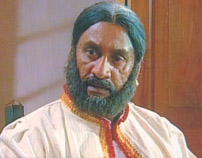 Monarawila , a thirty-two episode teledrama, directed and produced by
veteran actor Sathischandra Edirisinghe, will be telecast on Rupavahini
from June 20, 2006 every Thursday at 8.30 p.m.
Monarawila , a thirty-two episode teledrama, directed and produced by
veteran actor Sathischandra Edirisinghe, will be telecast on Rupavahini
from June 20, 2006 every Thursday at 8.30 p.m. 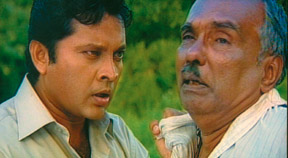 The rebellion was brutally cracked down by the British, following the
capture of rebel leaders such as Ahelepola and Pilimatalawa. Delawala
Manike and Tikirikumara who fled to Matale were also captured by the
British while hiding in the forest. The British also killed Ehalagama
Thera who supported the rebellion.Kiulegedara who retreated from
Wellassa was captured in Matale by the British while Monarawila
Kappetipola was in Parawahagama Walauwwa. However, both faced death
bravely.
The rebellion was brutally cracked down by the British, following the
capture of rebel leaders such as Ahelepola and Pilimatalawa. Delawala
Manike and Tikirikumara who fled to Matale were also captured by the
British while hiding in the forest. The British also killed Ehalagama
Thera who supported the rebellion.Kiulegedara who retreated from
Wellassa was captured in Matale by the British while Monarawila
Kappetipola was in Parawahagama Walauwwa. However, both faced death
bravely. 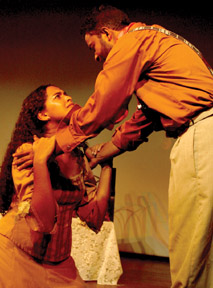 Take a breath and get ready for this. An imperious and spoilt
aristocratic woman, charismatic, strong willed and intelligent, unable
to find satisfaction in her limited world, yet paralysed by this fear of
scandal, manipulates the lives of those around her, to test her sexual
powers. Will her ruthless desperation end in tragic destruction?
Take a breath and get ready for this. An imperious and spoilt
aristocratic woman, charismatic, strong willed and intelligent, unable
to find satisfaction in her limited world, yet paralysed by this fear of
scandal, manipulates the lives of those around her, to test her sexual
powers. Will her ruthless desperation end in tragic destruction? 
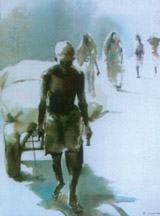
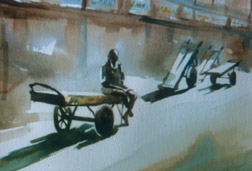 "The daily work load", an exhibition of paintings in water colour by
Anura Dahanayaka will be held at Alliance Francaise from June 22 to July
7 , 2006.
"The daily work load", an exhibition of paintings in water colour by
Anura Dahanayaka will be held at Alliance Francaise from June 22 to July
7 , 2006. 





